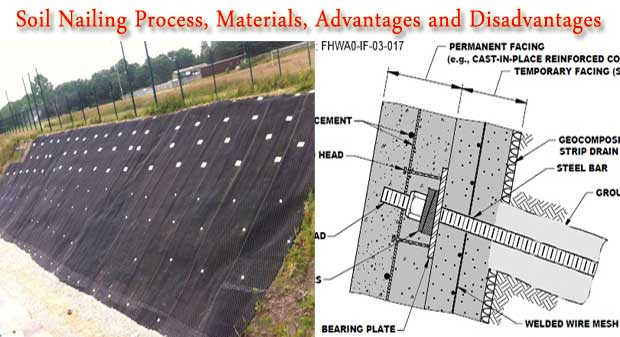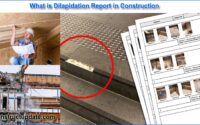Soil Nailing – Process, Advantages, and Disadvantage
Soil nailing is a process which is used for unstable natural soil slope to make it safe over-steeping with construction techniques. This article guides you through what is soil nailing, which materials should be used and about its advantages and disadvantages.
Origin of Soil Nailing:
Soil nailing evolved from the New Austrian Tunneling method which is a system for underground excavations in rock.
This concept was also been applied to the stabilization of rock slopes since the early 1960s.
The first application of soil nailing was implemented in 1972 for a railroad widening project near Versailles, France.

Nails:
- Driven Nails
- Grouted Nails
- Corrosion Protected Nails
- Jet grouted Nails
- Launched Nails
Machineries Used for Soil Nailing:
- Drilling Equipments
- Grout Mixing Equipments
- Shotcreting / Guniting Equipments
- Compressor
Materials Used for Soil Nailing:
- Steel Reinforcemtns
- Grout Mix
- Shotcrete / Gunite
Steel Reinforcements:
For corrosion protection, all steel components shall be galvanized.
If machine threading after galvanization is unavoidable, then proper zinc based coating shall be applied onto the thread.
For double corrosion protection, the PVC corrugated pipe used shall be of good quality and adequate thickness.
Grout Mix:
For conventional soil nail, the water-cement ratio of the grout mix ranges from 0.4 to 0.5.
The resistance at grout-soil interface of nail will significantly reduced when the grout shrink.
Shotcrete / Gunite:
Shotcrete of gunite can be a continuous flow of mortar or concrete mixes projected at high speed perpendicularly onto the exposed ground surface by means of pneumatic air blowing for dry mix or spraying for wet mix.
Initial Excavation:
This initial excavation will be carried out by trimming the original ground profit to the working platform level where the first row of soil nails can be practically installed.
The pre-requisited of this temporary excavation shall be in such a way that the trimmed surface must be able to self support till completion of nail installation.
Drilling of Holes:
Drilling can be done by either air-flushed percussion dirring, auguring or rotary wash boring drilling depending on ground condition.
The size of drilled hole shall be as per the designed dimension. Typically, the hole size can range from 100mm to 150mm.
Insertion of Nail Reinforcement And Grouting
The nail shall be prepared with adequate centralizers at appropirate spacing and for proper grount cover for first defense of corrosion protection.
In additional to this, galvanization and pre-grouted nail encapsulated with corrugated pipe can be considered for durability.
Advantages:
- With the right soil and site conditions, a rapid and economical means of constructing earth retention support systems and retaining walls.
- It creates less noise and traffic obstructions.
- Less impact on nearby properties
- Environmental friendly.
- Allow excellent working space in front of the excavation face,
- Grouting only once is required, saving time and labor.
- The technique is flexible, easily modified.
Disadvantages:
- Nail encroachment to retained ground rendering unusable underground space,
- The tendency of the high ground lost due to drilling technique, particularly at coarse-grained soil,
- Suitable only for excavation above groundwater.
Conclusion:
Soil nailing is an accepted technology, the theoretical aspects of which are well understood and well reported in technical literature.
However, research indicates that there are few practical guidelines available that offer a comprehensive, experience-based insight into the construction considerations that should be addressed before a soil nail system design is finalized and implemented.





